I have two UITextField instances and upon update I need to figure out which one is updated, usually I’d use === to check reference identity, but accidentally put == instead and it worked. So I wonder if UITextField conforms to Equatable and what actually are involved in comparison?
To illustrate:
let textFieldA = UITextField()
let textFieldB = UITextField()
textFieldA.text = "A"
textFieldB.text = "B"
print("A.text", textFieldA.text)
print("B.text", textFieldB.text)
print("A == A:", textFieldA == textFieldA)
print("A == B:", textFieldA == textFieldB)
print("A === B:", textFieldA === textFieldB)
textFieldB.text = "A"
print("A.text", textFieldA.text)
print("B.text", textFieldB.text)
print("A == A:", textFieldA == textFieldA)
print("A == B:", textFieldA == textFieldB)
print("A === B:", textFieldA === textFieldB)
Output:
A.text Optional("A")
B.text Optional("B")
A == A: true
A == B: false
A === B: false
A.text Optional("A")
B.text Optional("A")
A == A: true
A == B: false
A === B: false
So == and === works the same regardless of whether their text are same or different, I wonder what is happening under the hood?
Thanks!




2
Answers
UITextFieldextendsUIControl->UIView->UIResponder->NSObjectwhich conforms to theNSObjectprotocol.NSObjectconforms toHashablewhich extendsEquatable.Ultimately the Swift
==operator is going to call theisEqual:method thatUITextFieldinherits fromNSObject. The default implementation of this is to simply compare the pointer.UITextFielddoes not overrideisEqual:to compare thetextproperty or any other property. So the end result is that==and===are effectively the same in this case.Use
===when you only care about if the two references are to the same object. Don’t use==just because it gives the same result in this case. It’s possible that could change in some future update.UITextFieldis a subclass ofNSObject, andNSObjectconforms toHashable, which means it also conforms toEquatable.NSObject.==is implemented by delegating toisEqual, and the default implementation ofisEqualcompares object identities. See the code in NSObject.swift in the swift-corelibs-foundation implementation,And frankly, that is the only reasonable implementation of
NSObject.==I can think of.Evidently,
UITextFielddid not overrideisEqual, and so comparing with==produces the same result as comparing with===.